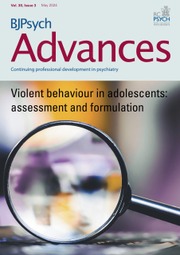Article contents
A unifying framework for suicide risk assessment: the source–problem–solution–motive (SPSM) model
Published online by Cambridge University Press: 14 May 2025
Summary
Suicidal and self-harming behaviours present a significant challenge for mental health services. Recent national guidelines advocate abandoning tools based on box-ticking and a move towards a personalised psychosocial assessment. This article examines evidence from theoretical and empirical research in this area and attempts to integrate it by introducing the source–problem–solution–motive (SPSM) model. The model, which builds on the contributions of other suicidologists, specially Jean Baechler, could be used as a framework for the assessment and management of these behaviours. The four stages of the model provide a comprehensive approach that enables an exploration of the internal logic of the behaviour. The model covers ‘because’ and ‘in-order-to’ motives. This allows a personalised approach, but also a structured one that can be taught and generalised.
Information
- Type
- Article
- Information
- BJPsych Advances , Volume 31 , Special Issue 6: Liaison Psychiatry (Part 1) , November 2025 , pp. 352 - 364
- Copyright
- © The Author(s), 2025. Published by Cambridge University Press on behalf of Royal College of Psychiatrists
References
- 1
- Cited by



eLetters
No eLetters have been published for this article.